An official website of the United States government
 United States Department of Labor
United States Department of Labor
Operate pile drivers mounted on skids, barges, crawler treads, or locomotive cranes to drive pilings for retaining walls, bulkheads, and foundations of structures such as buildings, bridges, and piers.
Employment estimate and mean wage estimates for Pile Driver Operators:
| Employment (1) | Employment RSE (3) |
Mean hourly wage |
Mean annual wage (2) |
Wage RSE (3) |
|---|---|---|---|---|
| 3,820 | 8.4 % | $ 34.56 | $ 71,880 | 3.4 % |
Percentile wage estimates for Pile Driver Operators:
| Percentile | 10% | 25% | 50% (Median) |
75% | 90% |
|---|---|---|---|---|---|
| Hourly Wage | $ 17.79 | $ 22.88 | $ 30.47 | $ 46.72 | $ 55.43 |
| Annual Wage (2) | $ 37,010 | $ 47,590 | $ 63,370 | $ 97,190 | $ 115,290 |
Industries with the highest published employment and wages for Pile Driver Operators are provided. For a list of all industries with employment in Pile Driver Operators, see the Create Customized Tables function.
Industries with the highest levels of employment in Pile Driver Operators:
| Industry | Employment (1) | Percent of industry employment | Hourly mean wage | Annual mean wage (2) |
|---|---|---|---|---|
| Other Heavy and Civil Engineering Construction | 1,490 | 1.24 | $ 38.62 | $ 80,340 |
| Other Specialty Trade Contractors | 870 | 0.13 | $ 29.59 | $ 61,550 |
| Highway, Street, and Bridge Construction | 820 | 0.23 | $ 33.97 | $ 70,670 |
| Nonresidential Building Construction | 210 | 0.03 | $ 32.41 | $ 67,420 |
| Utility System Construction | 180 | 0.03 | $ 33.83 | $ 70,370 |
Industries with the highest concentration of employment in Pile Driver Operators:
| Industry | Employment (1) | Percent of industry employment | Hourly mean wage | Annual mean wage (2) |
|---|---|---|---|---|
| Other Heavy and Civil Engineering Construction | 1,490 | 1.24 | $ 38.62 | $ 80,340 |
| Highway, Street, and Bridge Construction | 820 | 0.23 | $ 33.97 | $ 70,670 |
| Other Specialty Trade Contractors | 870 | 0.13 | $ 29.59 | $ 61,550 |
| Nonresidential Building Construction | 210 | 0.03 | $ 32.41 | $ 67,420 |
| Utility System Construction | 180 | 0.03 | $ 33.83 | $ 70,370 |
Top paying industries for Pile Driver Operators:
| Industry | Employment (1) | Percent of industry employment | Hourly mean wage | Annual mean wage (2) |
|---|---|---|---|---|
| Other Heavy and Civil Engineering Construction | 1,490 | 1.24 | $ 38.62 | $ 80,340 |
| Highway, Street, and Bridge Construction | 820 | 0.23 | $ 33.97 | $ 70,670 |
| Utility System Construction | 180 | 0.03 | $ 33.83 | $ 70,370 |
| Foundation, Structure, and Building Exterior Contractors | 130 | 0.01 | $ 32.67 | $ 67,950 |
| Nonresidential Building Construction | 210 | 0.03 | $ 32.41 | $ 67,420 |
States and areas with the highest published employment, location quotients, and wages for Pile Driver Operators are provided. For a list of all areas with employment in Pile Driver Operators, see the Create Customized Tables function.
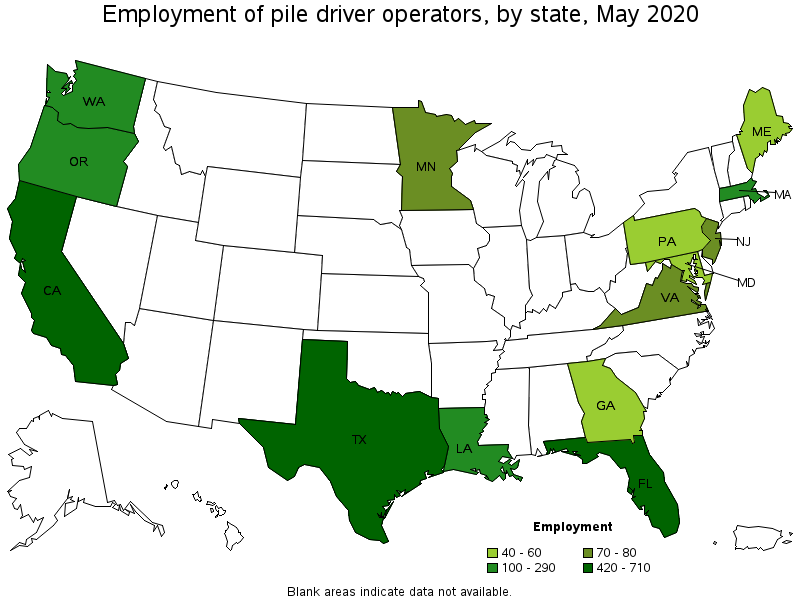
States with the highest employment level in Pile Driver Operators:
| State | Employment (1) | Employment per thousand jobs | Location quotient (9) | Hourly mean wage | Annual mean wage (2) |
|---|---|---|---|---|---|
| Texas | 710 | 0.06 | 2.14 | $ 32.00 | $ 66,560 |
| California | 630 | 0.04 | 1.39 | $ 45.90 | $ 95,480 |
| Florida | 420 | 0.05 | 1.81 | $ 24.35 | $ 50,650 |
| Massachusetts | 290 | 0.09 | 3.21 | $ 41.16 | $ 85,610 |
| Louisiana | 210 | 0.12 | 4.20 | $ 24.82 | $ 51,620 |
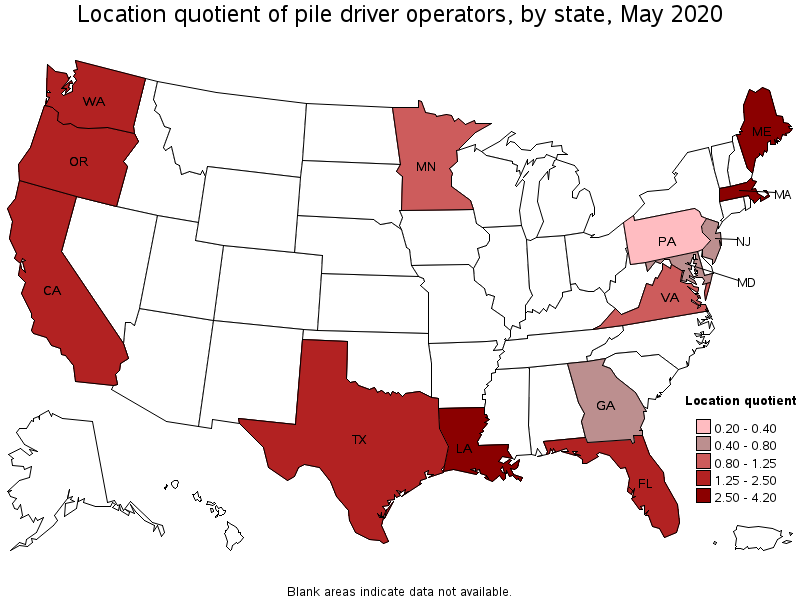
States with the highest concentration of jobs and location quotients in Pile Driver Operators:
| State | Employment (1) | Employment per thousand jobs | Location quotient (9) | Hourly mean wage | Annual mean wage (2) |
|---|---|---|---|---|---|
| Louisiana | 210 | 0.12 | 4.20 | $ 24.82 | $ 51,620 |
| Maine | 60 | 0.11 | 3.92 | $ 23.07 | $ 47,980 |
| Massachusetts | 290 | 0.09 | 3.21 | $ 41.16 | $ 85,610 |
| Texas | 710 | 0.06 | 2.14 | $ 32.00 | $ 66,560 |
| Oregon | 100 | 0.06 | 2.04 | $ 36.29 | $ 75,490 |
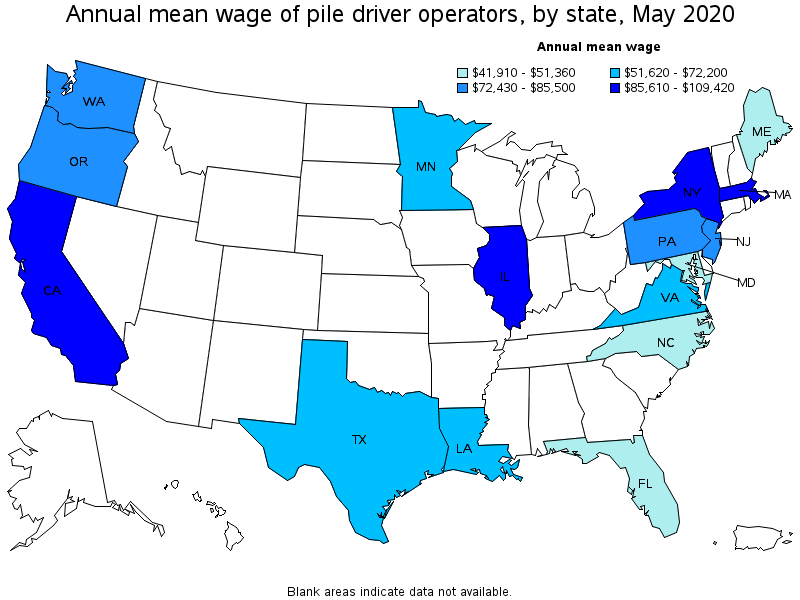
Top paying states for Pile Driver Operators:
| State | Employment (1) | Employment per thousand jobs | Location quotient (9) | Hourly mean wage | Annual mean wage (2) |
|---|---|---|---|---|---|
| New York | (8) | (8) | (8) | $ 52.60 | $ 109,420 |
| Illinois | (8) | (8) | (8) | $ 48.43 | $ 100,740 |
| California | 630 | 0.04 | 1.39 | $ 45.90 | $ 95,480 |
| Massachusetts | 290 | 0.09 | 3.21 | $ 41.16 | $ 85,610 |
| Pennsylvania | 50 | 0.01 | 0.32 | $ 41.10 | $ 85,500 |
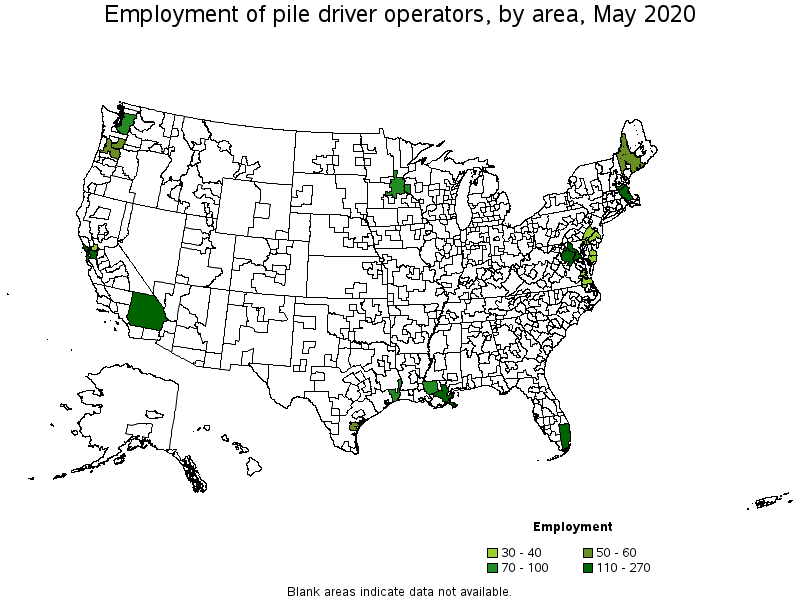
Metropolitan areas with the highest employment level in Pile Driver Operators:
| Metropolitan area | Employment (1) | Employment per thousand jobs | Location quotient (9) | Hourly mean wage | Annual mean wage (2) |
|---|---|---|---|---|---|
| Boston-Cambridge-Nashua, MA-NH | 270 | 0.11 | 3.85 | $ 41.42 | $ 86,160 |
| San Francisco-Oakland-Hayward, CA | 260 | 0.11 | 4.04 | $ 46.95 | $ 97,650 |
| Miami-Fort Lauderdale-West Palm Beach, FL | 140 | 0.06 | 2.10 | $ 27.42 | $ 57,030 |
| Washington-Arlington-Alexandria, DC-VA-MD-WV | 120 | 0.04 | 1.39 | $ 32.10 | $ 66,770 |
| New Orleans-Metairie, LA | 110 | 0.22 | 8.00 | $ 22.91 | $ 47,660 |
| Riverside-San Bernardino-Ontario, CA | 110 | 0.08 | 2.75 | $ 42.90 | $ 89,230 |
| Seattle-Tacoma-Bellevue, WA | 100 | 0.05 | 1.80 | (8) | (8) |
| Baton Rouge, LA | 80 | 0.22 | 7.85 | $ 27.76 | $ 57,740 |
| Beaumont-Port Arthur, TX | 70 | 0.46 | 16.82 | $ 26.45 | $ 55,010 |
| Minneapolis-St. Paul-Bloomington, MN-WI | 70 | 0.04 | 1.30 | $ 34.71 | $ 72,200 |
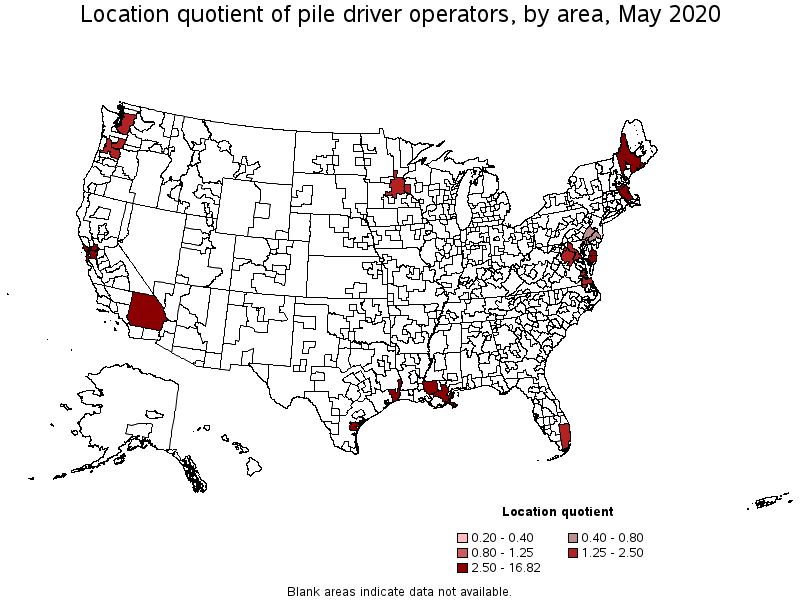
Metropolitan areas with the highest concentration of jobs and location quotients in Pile Driver Operators:
| Metropolitan area | Employment (1) | Employment per thousand jobs | Location quotient (9) | Hourly mean wage | Annual mean wage (2) |
|---|---|---|---|---|---|
| Beaumont-Port Arthur, TX | 70 | 0.46 | 16.82 | $ 26.45 | $ 55,010 |
| Vallejo-Fairfield, CA | 40 | 0.29 | 10.67 | (8) | (8) |
| Corpus Christi, TX | 50 | 0.28 | 10.36 | $ 27.97 | $ 58,170 |
| Salisbury, MD-DE | 30 | 0.22 | 8.15 | $ 16.23 | $ 33,750 |
| New Orleans-Metairie, LA | 110 | 0.22 | 8.00 | $ 22.91 | $ 47,660 |
| Baton Rouge, LA | 80 | 0.22 | 7.85 | $ 27.76 | $ 57,740 |
| San Francisco-Oakland-Hayward, CA | 260 | 0.11 | 4.04 | $ 46.95 | $ 97,650 |
| Boston-Cambridge-Nashua, MA-NH | 270 | 0.11 | 3.85 | $ 41.42 | $ 86,160 |
| Riverside-San Bernardino-Ontario, CA | 110 | 0.08 | 2.75 | $ 42.90 | $ 89,230 |
| Miami-Fort Lauderdale-West Palm Beach, FL | 140 | 0.06 | 2.10 | $ 27.42 | $ 57,030 |
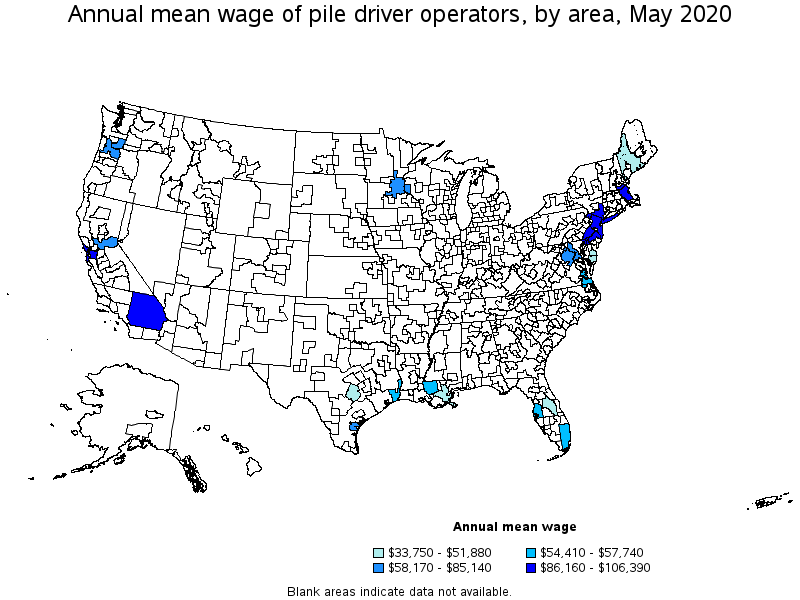
Top paying metropolitan areas for Pile Driver Operators:
| Metropolitan area | Employment (1) | Employment per thousand jobs | Location quotient (9) | Hourly mean wage | Annual mean wage (2) |
|---|---|---|---|---|---|
| Philadelphia-Camden-Wilmington, PA-NJ-DE-MD | 40 | 0.02 | 0.57 | $ 51.15 | $ 106,390 |
| New York-Newark-Jersey City, NY-NJ-PA | (8) | (8) | (8) | $ 51.04 | $ 106,160 |
| San Francisco-Oakland-Hayward, CA | 260 | 0.11 | 4.04 | $ 46.95 | $ 97,650 |
| Riverside-San Bernardino-Ontario, CA | 110 | 0.08 | 2.75 | $ 42.90 | $ 89,230 |
| Boston-Cambridge-Nashua, MA-NH | 270 | 0.11 | 3.85 | $ 41.42 | $ 86,160 |
| Portland-Vancouver-Hillsboro, OR-WA | 50 | 0.04 | 1.53 | $ 40.93 | $ 85,140 |
| Minneapolis-St. Paul-Bloomington, MN-WI | 70 | 0.04 | 1.30 | $ 34.71 | $ 72,200 |
| Sacramento--Roseville--Arden-Arcade, CA | (8) | (8) | (8) | $ 32.63 | $ 67,870 |
| Washington-Arlington-Alexandria, DC-VA-MD-WV | 120 | 0.04 | 1.39 | $ 32.10 | $ 66,770 |
| Corpus Christi, TX | 50 | 0.28 | 10.36 | $ 27.97 | $ 58,170 |
Nonmetropolitan areas with the highest employment in Pile Driver Operators:
| Nonmetropolitan area | Employment (1) | Employment per thousand jobs | Location quotient (9) | Hourly mean wage | Annual mean wage (2) |
|---|---|---|---|---|---|
| Southwest Maine nonmetropolitan area | 60 | 0.33 | 12.01 | $ 23.00 | $ 47,830 |
Nonmetropolitan areas with the highest concentration of jobs and location quotients in Pile Driver Operators:
| Nonmetropolitan area | Employment (1) | Employment per thousand jobs | Location quotient (9) | Hourly mean wage | Annual mean wage (2) |
|---|---|---|---|---|---|
| Southwest Maine nonmetropolitan area | 60 | 0.33 | 12.01 | $ 23.00 | $ 47,830 |
Top paying nonmetropolitan areas for Pile Driver Operators:
| Nonmetropolitan area | Employment (1) | Employment per thousand jobs | Location quotient (9) | Hourly mean wage | Annual mean wage (2) |
|---|---|---|---|---|---|
| Southwest Maine nonmetropolitan area | 60 | 0.33 | 12.01 | $ 23.00 | $ 47,830 |
These estimates are calculated with data collected from employers in all industry sectors, all metropolitan and nonmetropolitan areas, and all states and the District of Columbia. The top employment and wage figures are provided above. The complete list is available in the downloadable XLS files.
The percentile wage estimate is the value of a wage below which a certain percent of workers fall. The median wage is the 50th percentile wage estimate—50 percent of workers earn less than the median and 50 percent of workers earn more than the median. More about percentile wages.
(1) Estimates for detailed occupations do not sum to the totals because the totals include occupations not shown separately. Estimates do not include self-employed workers.
(2) Annual wages have been calculated by multiplying the hourly mean wage by a "year-round, full-time" hours figure of 2,080 hours; for those occupations where there is not an hourly wage published, the annual wage has been directly calculated from the reported survey data.
(3) The relative standard error (RSE) is a measure of the reliability of a survey statistic. The smaller the relative standard error, the more precise the estimate.
(8) Estimate not released.
(9) The location quotient is the ratio of the area concentration of occupational employment to the national average concentration. A location quotient greater than one indicates the occupation has a higher share of employment than average, and a location quotient less than one indicates the occupation is less prevalent in the area than average.
Other OEWS estimates and related information:
May 2020 National Occupational Employment and Wage Estimates
May 2020 State Occupational Employment and Wage Estimates
May 2020 Metropolitan and Nonmetropolitan Area Occupational Employment and Wage Estimates
May 2020 National Industry-Specific Occupational Employment and Wage Estimates
Last Modified Date: March 31, 2021